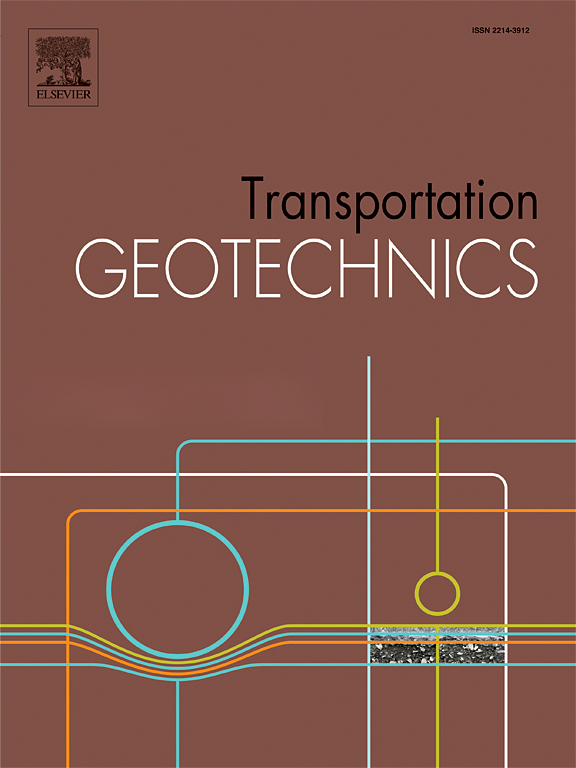Mechanical behavior of limestone ballast for heavy haul Brazilian railway lines: Laboratory evaluation
IF 5.5
2区 工程技术
Q1 ENGINEERING, CIVIL
引用次数: 0
Abstract
Railway ballast is the granular material that supports the sleepers on a conventional railway track and whose mechanical behavior determines the performance and safety conditions of the track. The particles that make up ballast are generally derived from igneous or metamorphic rocks, particularly granite, basalt, gneiss, dolomite, rhyolite, and quartzite. Sedimentary rocks such as limestone are sometimes used but are not recommended. The purpose of this research is to evaluate the mechanical behavior of limestone ballast, specifically its shear strength, permanent deformation and particle breakage, with a view to determining its suitability for use in Brazilian heavy haul railway lines. This paper presents an experimental investigation of limestone aggregate through of monotonic and cyclic triaxial tests performed on full-scale ballast specimens. The monotonic triaxial tests were carried out at three different confining pressures to failure and to critical state, while the long-term cyclic tests (permanent deformation) were carried out in six stress paths compatible with real heavy haul loads, as well as milder and more severe stress levels. The results indicate that the limestone aggregate, despite the high proportion of non-cubic particles, can be satisfactorily used as a ballast material due to the high values of the strength parameters and the long-term deformability behavior, characterized by lower degradation and particle breakage and the tendency to stabilize the permanent deformation when the stress paths compatible with real-life heavy haul loadings were applied.
巴西重载铁路用石灰石镇流器的力学性能:实验室评价
铁路道砟是在常规铁路轨道上支撑轨枕的颗粒状材料,其力学性能决定了轨道的性能和安全状况。构成压舱物的颗粒通常来自火成岩或变质岩,特别是花岗岩、玄武岩、片麻岩、白云岩、流纹岩和石英岩。沉积岩,如石灰岩,有时使用,但不推荐。本研究的目的是评估石灰石镇流器的力学性能,特别是其抗剪强度、永久变形和颗粒破碎,以确定其在巴西重载铁路线上的适用性。本文通过对全尺寸压舱物试件进行单调试验和循环三轴试验,对石灰石骨料进行了试验研究。单调三轴试验在三种不同的围压下进行,直到破坏和临界状态,而长期循环试验(永久变形)在与实际重载载荷兼容的六种应力路径下进行,以及较轻和较严重的应力水平。结果表明,在与实际重载载荷相适应的应力路径下,尽管石灰石骨料的非立方颗粒比例较高,但其强度参数值较高,且具有较低的降解率和颗粒破碎率,且具有稳定永久变形的趋势,因此可以令人满意地用作压载材料。
本文章由计算机程序翻译,如有差异,请以英文原文为准。
求助全文
约1分钟内获得全文
求助全文
来源期刊

Transportation Geotechnics
Social Sciences-Transportation
CiteScore
8.10
自引率
11.30%
发文量
194
审稿时长
51 days
期刊介绍:
Transportation Geotechnics is a journal dedicated to publishing high-quality, theoretical, and applied papers that cover all facets of geotechnics for transportation infrastructure such as roads, highways, railways, underground railways, airfields, and waterways. The journal places a special emphasis on case studies that present original work relevant to the sustainable construction of transportation infrastructure. The scope of topics it addresses includes the geotechnical properties of geomaterials for sustainable and rational design and construction, the behavior of compacted and stabilized geomaterials, the use of geosynthetics and reinforcement in constructed layers and interlayers, ground improvement and slope stability for transportation infrastructures, compaction technology and management, maintenance technology, the impact of climate, embankments for highways and high-speed trains, transition zones, dredging, underwater geotechnics for infrastructure purposes, and the modeling of multi-layered structures and supporting ground under dynamic and repeated loads.
 求助内容:
求助内容: 应助结果提醒方式:
应助结果提醒方式:


